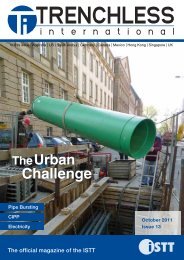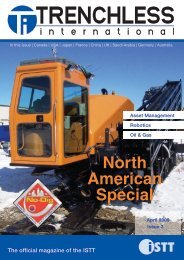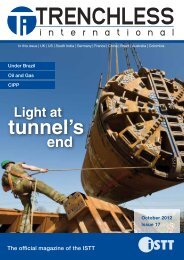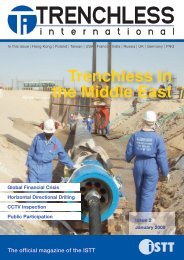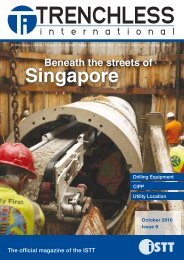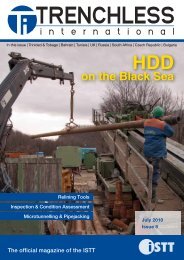Boring - Trenchless International
Boring - Trenchless International
Boring - Trenchless International
Create successful ePaper yourself
Turn your PDF publications into a flip-book with our unique Google optimized e-Paper software.
Record breaking crossing<br />
in South Carolina<br />
The completion of another record breaking pipe installation in the US, this<br />
time at Parris Island, a marine training base in Beaufort, South Carolina,<br />
marks a series of successful and lengthy crossings of Fusible PVC pipe.<br />
Peace River HDD pull.<br />
North america<br />
April 2010 - <strong>Trenchless</strong> <strong>International</strong><br />
Beaufort Jasper Water & Sewer<br />
Authority (BJWSA) contracted Mears<br />
Group, Inc. to horizontally directional<br />
drill two crossings, 6,400 feet of 16 inch<br />
DR 18 FPVC and 600 feet of 16 inch<br />
DR 21 FPVC under Archers Creek and<br />
Malecon Drive, respectively. Underground<br />
Solutions, Inc. (UGSI) supplied and<br />
fused the PVC (FPVC®) product pipe for<br />
this project.<br />
These installations are part of a project<br />
to divert the Parris Island wastewater<br />
flows to a BJWSA regional facility. The<br />
military base, Marine Corps Recruit<br />
Depot, trains about 17,000 recruits each<br />
year. BJWSA had previous experience<br />
with both Mears Group and UGSI during<br />
installation of 5,120 feet of 10 inch FPVC<br />
in 2008 to deliver reuse water to the<br />
Secession Golf Course on Lady’s Island.<br />
For two years, that stood as the record<br />
breaking crossing in a single pull using<br />
thermoplastic pipe.<br />
The first crossing of this most current<br />
project is the longest installation of PVC,<br />
with a drilled length of 6,400 feet. Installing<br />
the crossing from Jericho Island to Little<br />
Horse Island, the Mears’ crew drilled under<br />
tidal marshland on either side of Archers<br />
Creek. Mears utilised their 500,000 pound<br />
rig on the entry side at Jericho Island.<br />
They set up their 140,000 pound rig<br />
at the exit side of the crossing at Little<br />
Horse Island to assist in the pre-reaming<br />
operations. Mears used a jet sub with a 9<br />
7/8 inch bit during the pilot hole drilling.<br />
Drilling through clays, cemented sands,<br />
shells and gravel took careful steering.<br />
During pre-reaming, Mears opened the<br />
hole in three stages starting off with an<br />
18 inch hole opener, then 26 inches, and<br />
finally 34 inches. Before attempting to<br />
install the pipeline in the drilled crossing a<br />
barrel reamer was used to swab the hole.<br />
Because of the space restrictions and<br />
a requirement to keep traffic flowing on a<br />
busy road on the military base until the last<br />
minute, two prefabricated pipeline strings<br />
had to be fused together the day before<br />
the pullback.<br />
Down hole pressures and pull force<br />
were monitored carefully throughout the<br />
20 hour installation period. For this project<br />
with known conditions and confidence<br />
in the experience of the HDD contractor,<br />
UGSI allowed a maximum pulling load of<br />
175,000 pounds on the pipe – in practice<br />
the maximum tensile load applied at the<br />
drilling rig was only 83,000 pounds.<br />
The second crossing was across<br />
Mears’ 500,000 pound rig on the entry<br />
side of the project.<br />
Malecon Drive, which is the main road on<br />
Parris Island. During the 600 feet crossing,<br />
soft sands were encountered during drilling.<br />
Mears, using its 140,000 pound rig,<br />
pulled the FPVC pipe into place within two<br />
hours. The two drilled crossings are being<br />
connected in a conventional manner with<br />
restrained MJ fittings.<br />
Horizontal directional drilling with FPVC<br />
has become an economical approach<br />
for installing pipelines. PVC has a high<br />
strength to weight ratio, limited stretch<br />
under long duration loading, and corrosion<br />
resistance. Mears and UGSI have<br />
partnered together on many projects and<br />
successfully set record breaking crossings.<br />
The installation on Parris Island<br />
marks yet another record in length.<br />
Aerial view of the FPVC pipe strung along<br />
military housing.<br />
Peace River HDD intersect project<br />
by Dale Larison P.Eng, Engineering Co-ordinator, Engineering Technology Inc.<br />
TransCanada Pipelines’ North Central Corridor Project presented an exciting opportunity to<br />
push the boundaries of horizontal directional drilling in Canada. Near the town of Manning in<br />
northwestern Alberta a 42 inch natural gas pipeline had to cross the Peace River.<br />
The Peace River horizontal directional<br />
drilling (HDD) called for a 1,110 metre<br />
horizontal directional drill opened to a<br />
final ream diameter of 54 inches to allow<br />
for the installation of the 42 inch pipeline<br />
pullback section. The principal challenges<br />
faced by the crossing project were a limited<br />
construction season due to the need<br />
for frozen access roads and deep surface<br />
gravels at the crossing location.<br />
The general contractor was Louisburg<br />
Pipeline while Engineering Technology<br />
Inc. (Entec) provided engineering services<br />
and Direct Horizontal Drilling was the<br />
HDD contractor on the crossing.<br />
Engineering design and<br />
geotechnical investigation<br />
During the design phase of the project,<br />
existing geophysical and geotechnical<br />
Under the Peace River<br />
Justin Hedemann from HDD contractor Direct Horizontal Drilling spoke to <strong>Trenchless</strong><br />
<strong>International</strong> about the North Central Corridor (NCC) for the Trans Canada Pipeline.<br />
There were three large drills on the NCC pipeline.<br />
1. Peace River Intersect – 1,107 metres<br />
2. Little Cadotte – 701 metres<br />
3. Loon River – 635 metres<br />
Peace River and Cadotte were completed in 2008–09 and Loon river in 2010.<br />
Mr Hedemann said that one of the biggest challenges was gravelly ground condition.<br />
This necessitated the installation of large casing barrel sizes, which ranged as<br />
high as 84 inches in diameter, before the pilot bore could be drilled. Direct Horizontal<br />
used the telescoping method to case through the gravel layer.<br />
“Also the Peace River is over 600 metres wide, which did not allow for surface<br />
navigation ‘Paratrack II’ over that span. Instead the earth’s magnetics were used.”<br />
Direct Horizontal used their 1.1 million pound American Augers rig and a 160,000<br />
pound American Augers rig to complete the pilot bore. The pullback required only<br />
200,000 lbs of force, considering that the product line weighed approximately 1<br />
million lbs the ease of the pull is accredited to the clean hole and Direct’s in house<br />
buoyancy design and execution team.<br />
gas<br />
April 2010 - <strong>Trenchless</strong> <strong>International</strong><br />
36<br />
37






